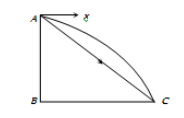11th And 12th > Physics
PROJECTILE MOTION MCQs
Total Questions : 45
| Page 1 of 5 pages
Answer: Option A. ->
r2r1
:
A
:
A
F = mv2r.If m and v are constants then F ∝1r
F1F2 = r2r1
Answer: Option B. ->
Due to lack of sufficient centripetal force
:
B
:
B
Due to lack of sufficient friction which provides the centripetal force.
Answer: Option C. ->
u sin θ
:
C
:
C
Since horizontal component of velocity remain always constant therefore only vertical component of velocity changes.
Initially vertical component u sin θ
Finally it becomes zero. So change in velocity =u sin θ
Answer: Option C. ->
A parabola
:
C
:
C
The path will be parabolic
Answer: Option B. ->
49.0 N–s
:
B
:
B
Change in momentum between complete projectile motion = 2mu sinθ=2×0.5×98×sin 30∘=49 N−s
Answer: Option D. ->
1 kg m sec−1
:
D
:
D
Horizontal momentum remains always constant. So change in vertical momentum (Δ →p) = Final vertical momentum – Initial vertical momentum =−mu sin θ
|ΔP|=0.1×20×sin 30∘=1 kg m/sec
Answer: Option B. ->
mv3(4√2g)
:
B
:
B
L=m u3 cosθ sin2 θ2g=mv3(4√2g) [As θ=45∘]
Answer: Option A. ->
P
:
A
:
A
Range of projectile will be minimum for that angle which is farthest from 45∘.


















